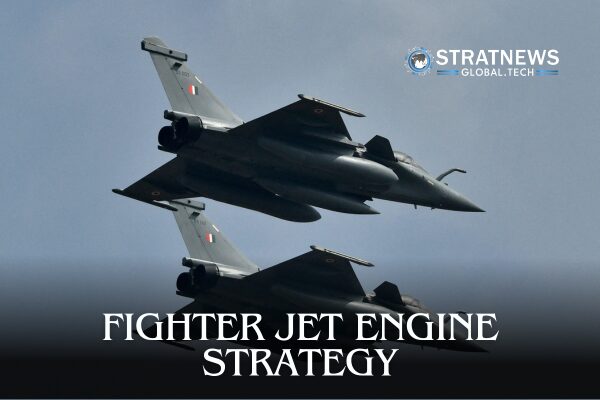India’s Fighter Jet Engine Strategy
In December 2024, China showcased two of its sixth-generation fighter aircraft, creating concern and changing the dynamics of the air superiority race. While the world is moving towards the sixth generation, India’s fighter jet stand at its latest 4.5 generation Dassault Rafale while concurrently developing an indigenous fifth-generation fighter aircraft, the Advanced Medium Combat Aircraft (AMCA).
The AMCA Mk1 variant is expected to be prototype-ready by 2028-29, powered by a couple of General Electric GE-414 engines, an evolution of the GE-404 engines used in Tejas. GE-404 faces production delays due to supply chain disruptions, which have slowed Tejas’ production. This experience has pushed India to seek an indigenously developed engine for AMCA Mk2. While India’s fighter jet strategy has pursued indigenous engines in the past, notably with the Kaveri program, the challenges encountered suggest that co-developing with foreign firms may be more favourable.
In light of the supply chain issues and geopolitical uncertainties, India can take three paths: collaborate with Western companies at the cost and downside of limited technology transfer, rethink indigenous development of the 110 kN thrust engines (35% higher thrust than the Kaveri engine), or co-develop with nations seeking their own jet engines, like South Korea and Japan. India can leverage the Kaveri engine experience while benefiting from Korean or Japanese precision manufacturing and materials. While collaboration with South Korea and Japan will require a longer timeline than the development with technologically advanced Western companies, it still offers a more balanced partnership.
The Indigenous Route
The indigenous Kaveri engine, developed by the Gas Turbine Research Establishment (GTRE), is a complete engine capable of producing 70 kN of thrust. This project showcased India’s effort to build an aero engine. However, Kaveri’s thrust is 13% lower and weight 12% higher than required for LCA Tejas. Though unfit for LCA Tejas, the Kaveri engine will power the Ghatak Unmanned Combat Air Vehicle (UCAV).
The indigenous development of an aero engine is a complex process that requires skill, knowledge, capital, and time. The Kaveri engine program has taken over three decades. Designing and building aero engines is crucial for strategic autonomy. Hence, this should be a long-term program, and relying on Indigenous development for an aircraft ready to fly by the end of this decade will not be practical. Given the current situation, it won’t be a viable option for AMCA Mk2.
The Western Option: Advanced Capabilities, High Dependence
At Aero India, whispers became loud hints that India looks forward to collaborating with aero engine giants such as Safran (France) and Rolls-Royce (UK). However, the challenge is that Western OEMs will dictate the terms. They would gladly offer an engine but will use the Intellectual Property card for critical technology transfer. The key question is whether India is ready to collaborate with established engine manufacturers.
Kaveri project technology offers leverage for collaboration. However, Western companies have already mastered these technologies, leaving little incentive to co-develop an engine with India. This may result in a limited manufacturing or assembly deal, like the production of the Adour engine for the Jaguar aircraft.
The Eastern Alternative: Balanced Collaboration
India has limited collaboration with Japan and South Korea, which is reflected in the minimal participation of Japanese and South Korean companies at Aero India 2025. However, both countries are pursuing fifth-generation aircraft programs – South Korea’s KF-21 Boramae and Japan’s F-X – but like India lack indigenous jet engines. With China as a shared strategic concern, collaborating with eastern counterparts will be meaningful and strategically desirable.
Co-developing a next-generation engine with Japan or South Korea offers a more balanced route. India can share its expertise from the Kaveri program while benefiting from precision manufacturing capabilities from its East Asian counterparts. Unlike Western collaboration, which often comes with tight IP control, a joint Indo-Korean or Indo-Japanese effort could allow India to maintain greater control over its future fighter jet programs.
Looking east also comes with its drawbacks, which need to be addressed. While Japan has active defence cooperation with India, co-development of defence technology remains limited. This is due to the restrictive defence export policy and the pacifist constitution. The co-development of Unified Complex Radio Antenna (UNICORN) masts in November 2024 marks the beginning of such collaboration. Unlike Japan, South Korea has already engaged with India in customising the K9 Thunder Self-Propelled Howitzer. Hence, pursuing the co-development of the next-generation jet engine would be an easier pathway.
India stands at a critical juncture in deciding the future of its indigenous fighter jet program. Western OEMs offer advanced tech but come with dependency risks. The Indigenous route is a long-term goal and may not be a solution for the AMCA. A joint engine development with Japan or South Korea could achieve the best balance of technology access and better knowledge and technology gain. In the global race for air dominance, India’s engine decision will shape not just its aircraft but its autonomy.


